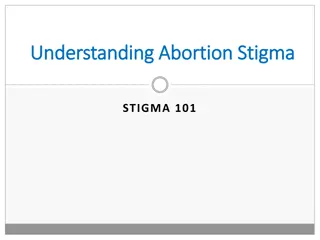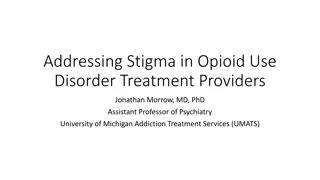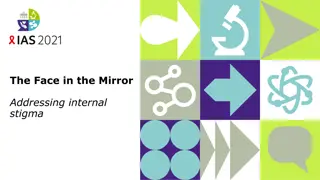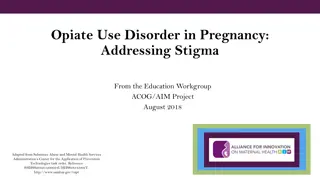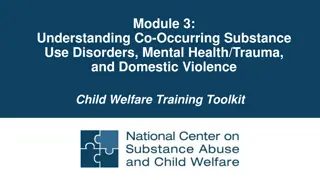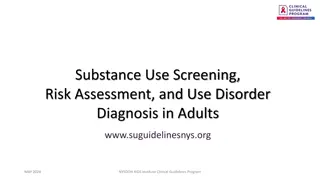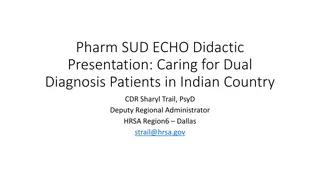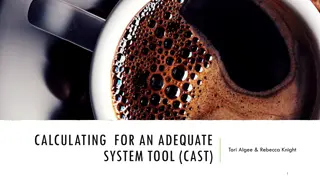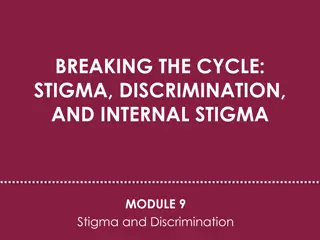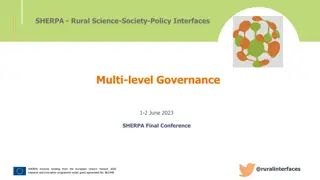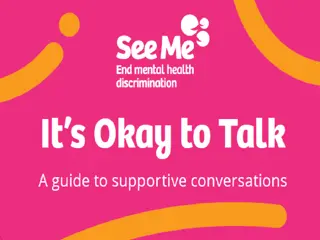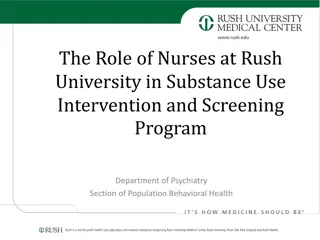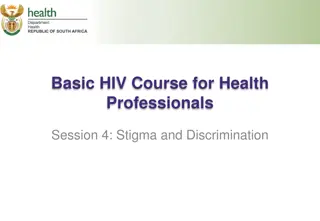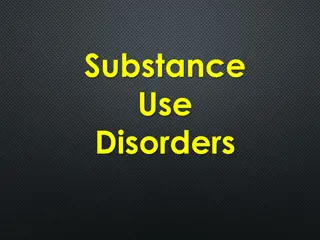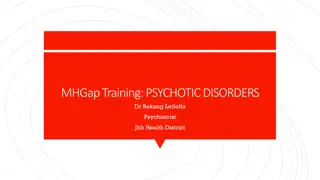Impact of Stigma and Substance Use Disorders in Rural Areas
Rural communities face challenges related to stigma and substance use disorders, including limited transportation and treatment options. Stigma may be heightened in these areas due to privacy concerns and lack of confidentiality. Initiating evidence-based methods and implementing harm reduction strategies can help combat stigma and reduce barriers to seeking treatment in rural communities.
Download Presentation

Please find below an Image/Link to download the presentation.
The content on the website is provided AS IS for your information and personal use only. It may not be sold, licensed, or shared on other websites without obtaining consent from the author. Download presentation by click this link. If you encounter any issues during the download, it is possible that the publisher has removed the file from their server.
E N D
Presentation Transcript
The Rural Impact on Stigma and Substance Use Disorders (SUDs) Prepared by Mountain Plains ATTC University of North Dakota Grand Forks, ND 58202 701-777-4520
Rural Areas Rural communities are more geographically dispersed There tend to be fewer public transportation options There may be a lack of local, or even close distance, treatment facilities therefore, people in rural communities may not seek SUD treatment
SUD Stigma in Rural Areas may be Heightened Secondary to: Diminished privacy and difficulty maintaining confidentiality Everyone knows each other The local healthcare provider serves on the school board with you You are friends with clinic staff Your neighbors know your vehicle which means they know when you are at the clinic!
How do Rural Areas Begin to Combat Stigma Challenges? Address barriers and challenges Cultural sensitivity trainings Offer technical assistance to healthcare providers, supporting people with substance abuse issues Is telehealth an option in your rural community? Implement evidence-based methods to reduce the stigma of SUDs
Evidence-Based Methods to Reduce the Stigma of SUDs For those with SUDs: Acceptance and Commitment Therapy Skills training Vocational counseling program (Livingston, J., Milne, T., Fang, M.L., & Amari, E., 2011)
Evidence-Based Methods to Reduce the Stigma of SUDs To Initiate Harm Reduction: Needle exchanges Substitution therapies Safe drug consumption rooms that are designed to decrease the risk associated with drug use (Livingston, J., Milne, T., Fang, M.L., & Amari, E., 2011)
Evidence-Based Methods to Reduce the Stigma of SUDs For the Public: Educational fact sheets Leaflets of positive stories of individuals with SUD who are in recovery (Livingston, J., Milne, T., Fang, M.L., & Amari, E., 2011)
Rural Programs can also Address Stigma through Good Samaritan Protections Good Samaritan Drug Overdose Laws: Provide immunity from criminal prosecution to individuals experiencing an overdose or their companion to request emergency services during an overdose in an effort to prevent overdose-related fatalities These laws can also help to support naloxone expansion programs by providing immunity from criminal prosecution to individuals experiencing an overdose or their companion to request emergency services during an overdose in an effort to prevent overdose-related fatalities. Retrieved from https://www.ruralhealthinfo.org/toolkits/substance-abuse/2/harm-reduction/naloxone#good-samaritan
Case Study Case Study for Discussion
Case Study Overview Chris is a person with SUD, who lives in a community of 1,000 people. The nearest SUD counseling services are an hour drive away from Chris home community, and the nearest facility which provides medication assisted treatment (MAT) services is over two hours away. The only provider in Chris home community is a family practice physician, who is not waivered to prescribe MAT. His kids play basketball with one of Chris kids, and the office manager in his practice is Chris cousin. Chris once tried to bring up concerns about drug usage with the local minister, but the minister s stance is that misuse of drugs and alcohol is a sin.
Case Study Or perhaps. . . Imagine now that Chris is a single mother of two young children, and is pregnant with a third.
References Browne, T., Priester, M., Clone, S., Iachini, A., DeHart, D., & Hock, R. (2016). Barriers and facilitators to substance use treatment in the rural south: A qualitative study. The Journal of Rural Health, 32(), 92-101. Livingston, J., Milne, T., Fang, M.L., & Amari, E. (2011). The effectiveness of interventions for reducing stigma related to substance use disorders: a systematic review. Addiction, 107(), 39-50. Luoma J, Kohlenberg B, Hayes S, Bunting K, Rye A. Reducing self-stigma in substance abuse through acceptance and commitment therapy: Model, manual development, and pilot outcomes. Addiction Research & Theory. April 2008;16(2):149-165. Available from: Health Source: Nursing/Academic Edition, Ipswich, MA. Accessed June 4, 2018. National Center for Frontier Communities. (2014). Mapping Process and Data. Retrieved from http://frontierus.org/mapping-process-and-data/ Prevention Collaboration in Action: Collaborating to Address the Opioid Crisis: Engaging People Who Use Drugs in Prevention Efforts: Strategies for Reducing Stigma. Retrieved from http://captcollaboration.edc.org/sites/captcollaboration.edc.org/files/attachments/engagin g-people-who-use-drugs-strategies-reducing-stigma_0.pdf Pullen, E., & Oser, C. (2014). Barriers to Substance Abuse Treatment in Rural and Urban Communities: A Counselor Perspective. Subst Use Misuse, 49(7), 891-901. Rural Health Information:stigma(2017). Retrieved from http://www.ruralhealthinfo.org Samhsa s Center For The Application Of Prevention Technologies. (2017). Retrieved from http://www.samhsa.gov/capt/ Smith, L.R., Earnshaw, V.A., & Copenhaver, M.M. (2016, May). Substance use stigma: Reliability and validity of a theory-based scale for substance-using populations. Drug and Alcohol Dependence, 162(1), 34-43. The National Alliance Of Advocates For Buprenorphine Treatment.NAABT.org (2008). Retrieved from http://file:///C:/Users/cjord/Downloads/NAABT_Language.pdf
References RHIhub. (n.d.). Frontier Counties (Fewer than 7 people per square mile). Retrieved from https://www.ruralhealthinfo.org/rural-maps/mapfiles/frontier.jpg Rural Health Information:stigma(2017). Retrieved from http://www.ruralhealthinfo.org Samhsa s Center For The Application Of Prevention Technologies. (2017). Retrieved from http://www.samhsa.gov/capt/ Smith, L.R., Earnshaw, V.A., & Copenhaver, M.M. (2016, May). Substance use stigma: Reliability and validity of a theory-based scale for substance-using populations. Drug and Alcohol Dependence, 162(1), 34-43. The National Alliance Of Advocates For Buprenorphine Treatment.NAABT.org (2008). Retrieved from http://file:///C:/Users/cjord/Downloads/NAABT_Language.pdf






